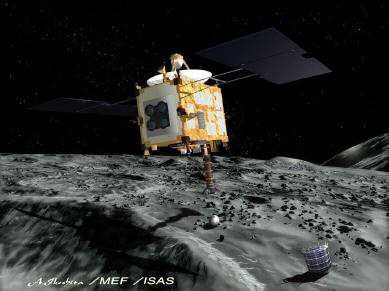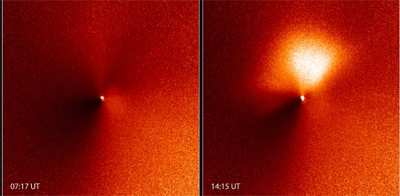Future Planetary Science Strategy Will Be Rolled Out In
Texas
 NASA researchers and other scientists will present findings
that provide new insights into the evolution of the solar system
during the 42nd annual Lunar and Planetary Science Conference. The
conference will run March 7-11 at the Woodlands Waterway Marriott
Hotel and Convention Center in The Woodlands, TX.
NASA researchers and other scientists will present findings
that provide new insights into the evolution of the solar system
during the 42nd annual Lunar and Planetary Science Conference. The
conference will run March 7-11 at the Woodlands Waterway Marriott
Hotel and Convention Center in The Woodlands, TX.
Key events include the unveiling of future planetary science
strategy; early science results from a Japan Aerospace Exploration
Agency mission, called Hayabusa, that returned the first particle
samples from an asteroid; presentations about the recent comet
Hartley 2 flyby; and the upcoming MESSENGER mission, the first
spacecraft to orbit Mercury.
"The research presented at this conference illustrates the
breadth and depth of our increasing understanding of the bodies,
processes and events making up our solar system," said Eileen
Stansbery, director of the Astromaterials Research and Exploration
Science Directorate at NASA's Johnson Space Center. "Planetary
scientists use this forum to discuss directions for future mission
concepts and fields of inquiry to answer new questions uncovered by
current research."
Recent results describing evidence for water in the solar system
and incorporation into primitive bodies are providing new insights
into the evolution of our solar system. Three special sessions will
focus on ice processes of terrestrial bodies including Mars, Earth
and the icy moons of the outer solar system.

Japanese Hayabusa Spacecraft Artists Rendering
On June 13, 2010, the Japanese Hayabusa spacecraft ended its
dramatic seven-year mission, returning a tiny capsule containing
particles from asteroid Itokawa. It was the first mission ever to
return a sample of material snatched from the surface of a world
beyond the moon. Examination of the particles began in January of
this year, and researchers will reveal results of their initial
analyses.
NASA's Deep Impact space probe conducted an extended flyby of
comet Hartley 2 on Nov. 4, 2010. The flyby provided a wealth of
data for studies of a cometary nucleus. Members of the science team
and other collaborators who observed the flyby will present
findings.
Volatile species, such as water and carbon dioxide, and nonmetal
elements dissolved in magmas have many critical effects on the
formation and evolution of terrestrial planetary mantles and
crusts. Magmas are mixtures of molten rock, volatiles and solids. A
special session will explore contributions from analytical,
theoretical and experimental research on a range of topics
involving volatiles in planetary interiors and crusts.

Deep Impact As Seen From Hubble
The conference also will include a briefing about the Planetary
Decadal Survey at 1730 CST on March 7. The survey is a strategy
released by the National Research Council in Washington to
prioritize missions, research areas and observations ten or more
years into the future. The briefing's featured speaker will be
Steve Squyres of Cornell University. He is the survey's chair and
principal investigator for NASA's Mars Exploration Rovers.
The conference is hosted by the Lunar and Planetary Institute in
Houston. The institute is managed by the Universities Space
Research Association, a national, nonprofit consortium of
universities chartered in 1969 by the National Academy of Sciences
at NASA's request.
 ANN's Daily Aero-Term (04.14.24): Maximum Authorized Altitude
ANN's Daily Aero-Term (04.14.24): Maximum Authorized Altitude ANN's Daily Aero-Linx (04.14.24)
ANN's Daily Aero-Linx (04.14.24) Classic Aero-TV: 'We're Surviving'-- Kyle Franklin Describes Airshow Life 2013
Classic Aero-TV: 'We're Surviving'-- Kyle Franklin Describes Airshow Life 2013 Aero-News: Quote of the Day (04.14.24)
Aero-News: Quote of the Day (04.14.24) Airborne 04.09.24: SnF24!, Piper-DeltaHawk!, Fisher Update, Junkers
Airborne 04.09.24: SnF24!, Piper-DeltaHawk!, Fisher Update, Junkers





